Last weekend, I popped open my mini warehouse only to discover one of a car owner’s worst nightmares. One of my favorite cars, my 2008 Saturn Sky Red Line, had a seat with rapidly spreading mold. Sadly, this isn’t even the first time this has happened to me, but it’s now the fourth time. I’m tired of cleaning out mold, and now I’m wondering: How do I stop this from happening again?
If you’re a longtime reader, you may remember that, in 2022, I wrote a story about how my 2005 Smart Fortwo became filled with what I called “forbidden polka dots.” Right before I stored the car for the winter in 2021, I had an accident with a car cover that let about a gallon of water into the interior. I forgot to fully dry out the car before parking it, and my reward the next spring was a car that was full of mold.
My wife cleaned out the car, and it has been fine ever since. The mold has not come back. I haven’t even smelled the telltale scent of mold, either. Since then, I also haven’t had a problem with any of my other cars. I’d pop open my mini warehouse, drive away in whatever chariot I chose, and life would be good.
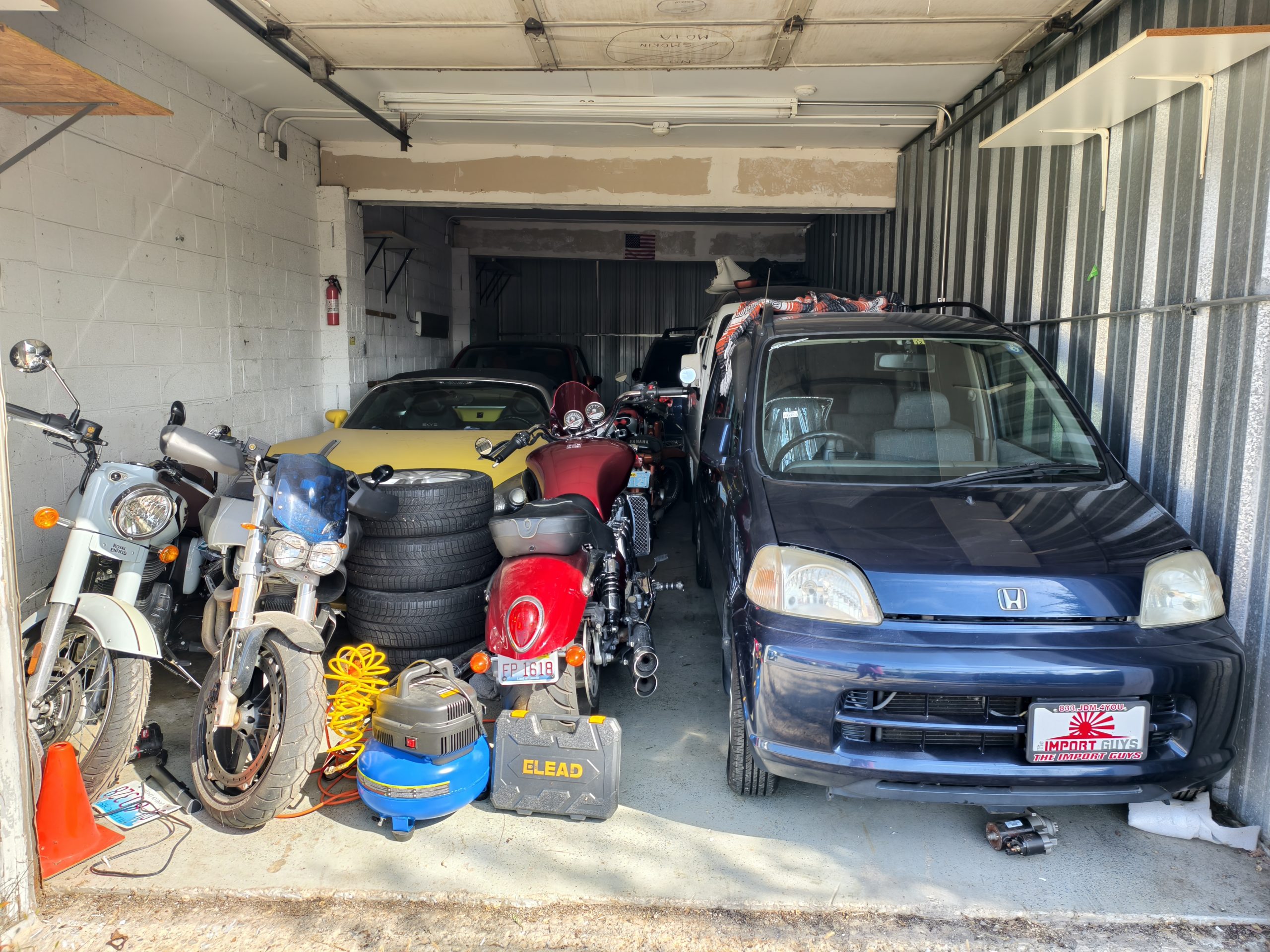
Something different must have happened this year, because it feels like I’ve been fighting a losing battle with mold this summer. I have found a grand total of three more of my cars with the stuff in them. I’m not exactly sure what’s going on, and I’m not entirely sure how to stop it.
Mold Is Nasty Stuff
Back in 2022, when I had the mold issue in my 2005 Smart Fortwo, there was an easy explanation: I was a goofball and stored a car with a gallon of water hiding under its carpet – a mold farm, basically.

The United States Environmental Protection Agency has a pretty good primer on mold:
Molds are a natural part of the environment and can be found almost anywhere that moisture and oxygen are present. They belong to the kingdom Fungi and live in moist places such as soil, plants and dead or decaying matter. Outdoors, molds play a part in nature by breaking down dead organic matter such as fallen leaves, dead trees and other debris; however, indoors mold growth should be avoided.
There are many types of mold – all of them need water or moisture to grow. When excessive moisture accumulates in buildings or on building materials, mold growth often occurs, particularly if the moisture problem remains undiscovered or unaddressed.
Molds spread by producing tiny reproductive cells called spores that waft through the air. Mold spores usually cannot be seen without magnification (ranging in size from 2-10 um) and are naturally present in both indoor and outdoor air. Some molds have spores that are easily disturbed and settle repeatedly with each disturbance. Other molds have sticky spores that will cling to surfaces and are dislodged by brushing against them or by other direct contact. Spores may remain able to grow for years after they are produced. In addition, whether or not the spores are alive, the allergens in and on them may remain allergenic for years.

Yeah, mold is the stuff of nightmares. It’s also really bad for you, and can cause Asthma attacks, headaches, and, depending on how your body reacts to its environment, more serious issues.
Generally, mold requires four factors to grow: moisture, oxygen, a temperature between 40 degrees and 100 degrees, and a food source that contains cellulose. Mold will happily grow on walls, fabric, wood, leather – even paper, if you let it. Also, a quirk about mold is that simply exposing the mold to a temperature extreme might not be enough to kill it. Mold may go dormant in freezing or hot temperatures, but it is unlikely to die based on a temperature swing alone. Once conditions permit growth again, the mold will just kick back into action.
My Storage Situation
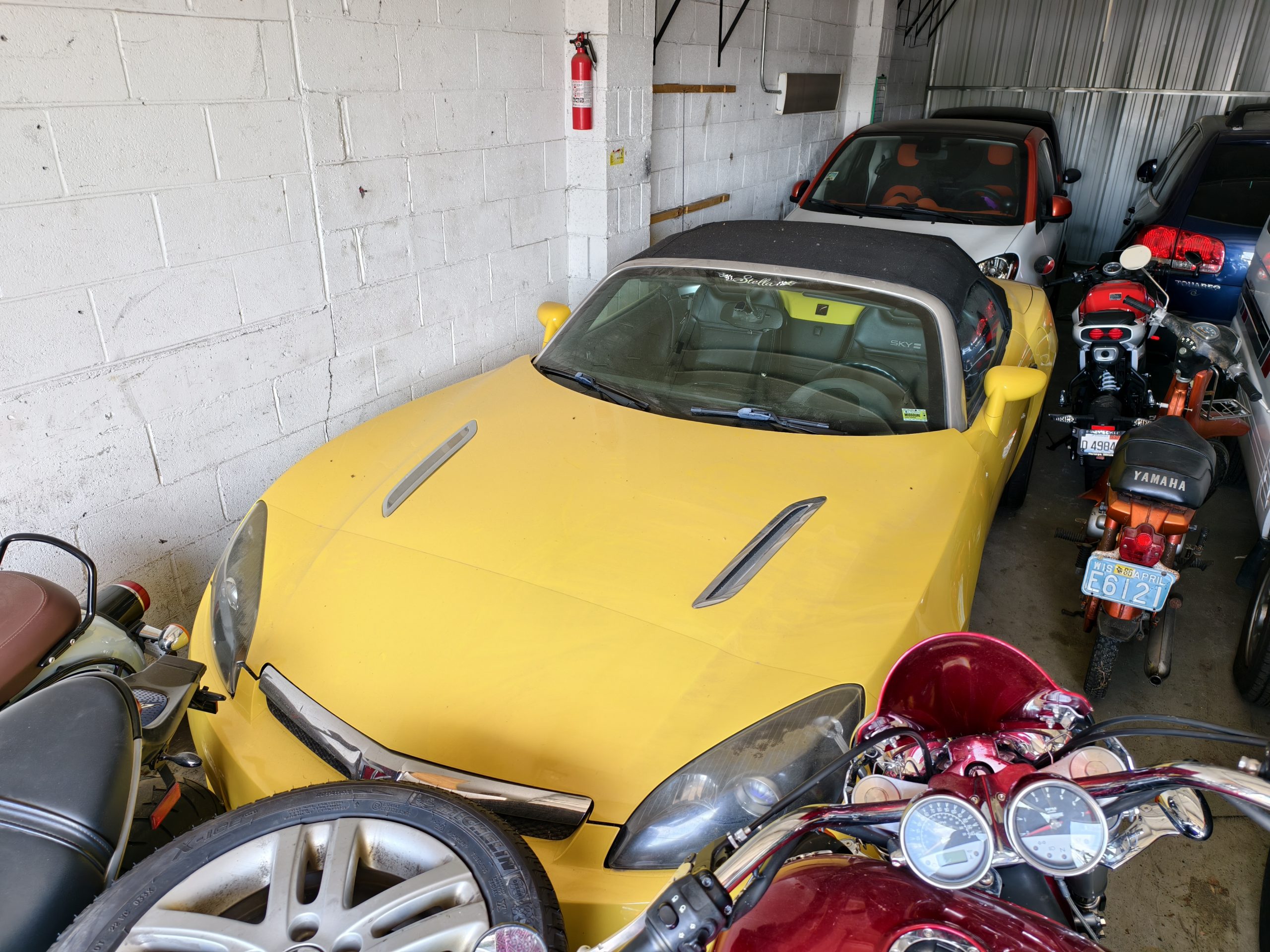
My mini warehouse is an interesting place. It sits maybe 500 feet from a lake and is more or less situated right in the middle of a chain of lakes. The area around my unit gets seriously humid. My warehouse also isn’t like a pole barn; the structure and floor of the building are concrete, and the roof appears to be not much different than what you’d find on top of an older commercial building. This is all to say that, based on the water stains on the ceiling in the building, this roof has leaked in the past. Likewise, the building gets extremely humid, just like the outside. So, at minimum, there’s a lot of water in the air. Also, spiders love this place, so I got that goin’ for me.
Here’s how Sheryl beat the crap out of the mold in my 2005 Smart:
Sheryl’s plan involves multiple prongs. The first involves this Bissell Little Green Pro cleaning machine. It injects searing hot water (or a chemical mix) into the surface that you’re cleaning and uses both brushing action and vacuum to get the job done. She combined it with RMR-86 Pro mold remover. The jug of RMR contains one of the active chemicals of bleach, among other harsh stuff.
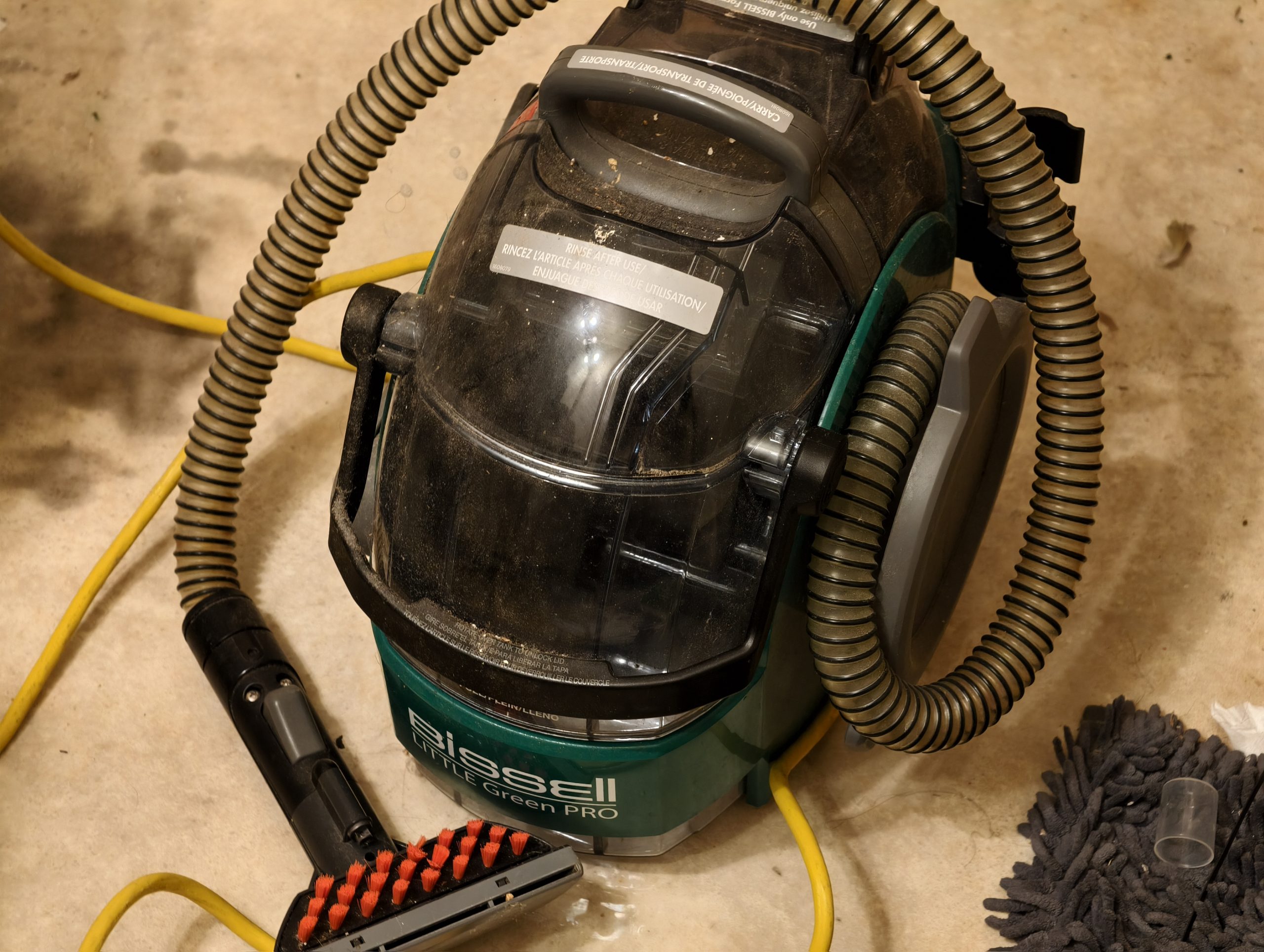
Sheryl made somewhat short work of the mold on the passenger seat. It took several passes and lots of scrubbing, but it took give or take an hour for her to be satisfied with the job.
[…]
Next came the driver seat, and she said that the growth on it was much worse. The seat bottom in particular required a lot of scrubbing to get through. However, after about two hours even it, too, looked extremely clean.

As I noted earlier, the mold hasn’t been back! So, this process worked out. I actually had doubts about this. It seems a lot of folks go hard on mold remediation, and remove their seats, dashboard, interior panels, and carpet to give them a ridiculously deep cleaning. Some folks straight up throw some of those parts away. Perhaps my car wasn’t bad enough to warrant tearing down the whole interior.
Here We Go Again
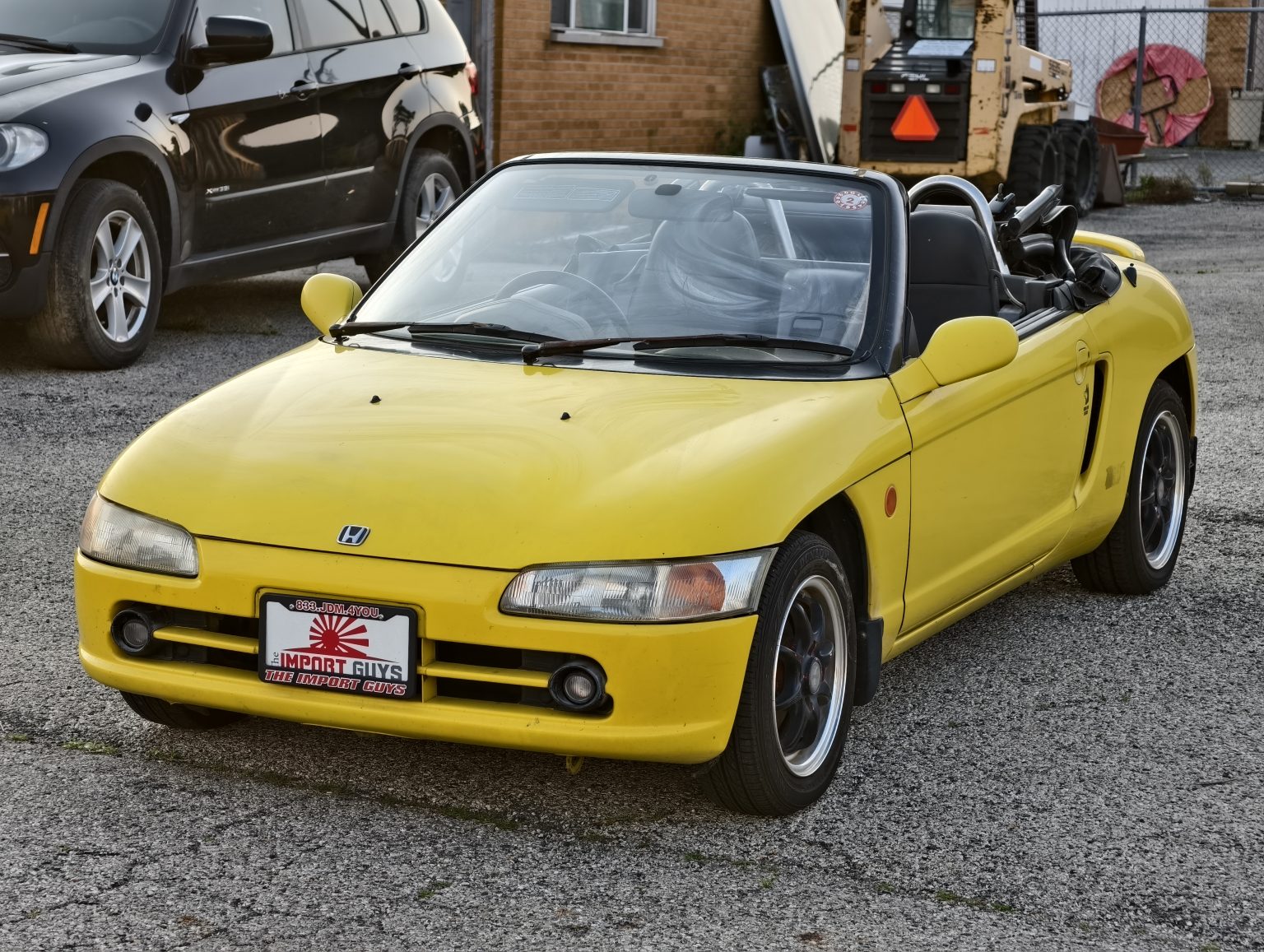
I figure the humidity supercharged the mold growth in that Smart. But I’m not entirely sure what happened this year with my other cars sprouting mold. Back in the spring, I excitedly attempted to drive my Honda Beat before finding its steering wheel covered in the fungi that are not fun guys. I cleaned up the mold with more of that RMR-86 stuff, monitored it for a while, and then sold the car.
Then, last week, I opened my unit hoping to drive my Saturn Sky Red Line, and was stopped hard by this sight:
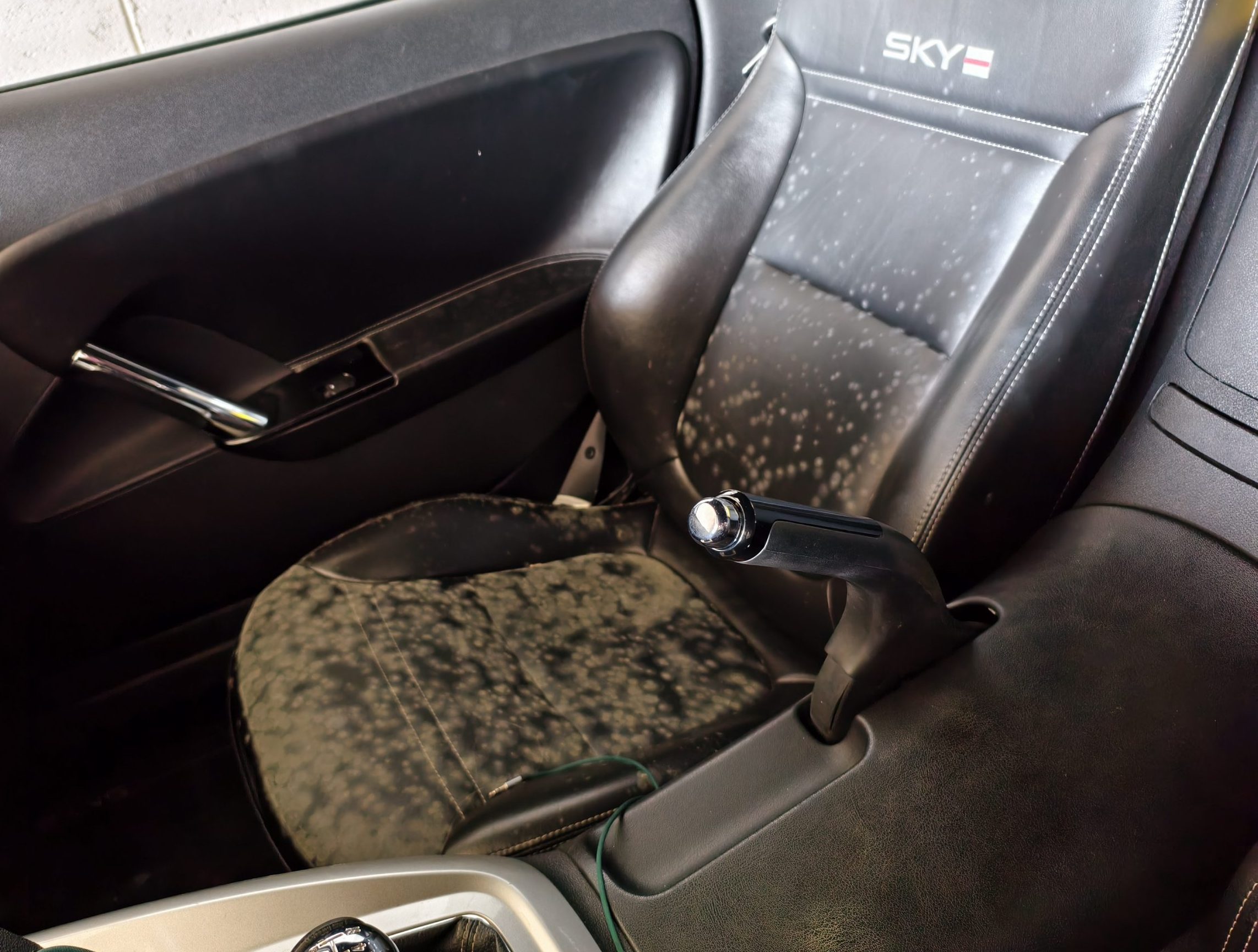
Crap.
This sent me into a panic, and I decided to check every other car in the unit. The 2006 Volkswagen Touareg V10 TDI was fine, as was the 2016 Smart Fortwo Edition #1, the 1997 Honda Life, and the 1989 Suzuki Every. All of the motorcycles were good, too. The only other troublemaker was the 2006 Smart Fortwo CDI, which had one little moldy dot on its driver seat.
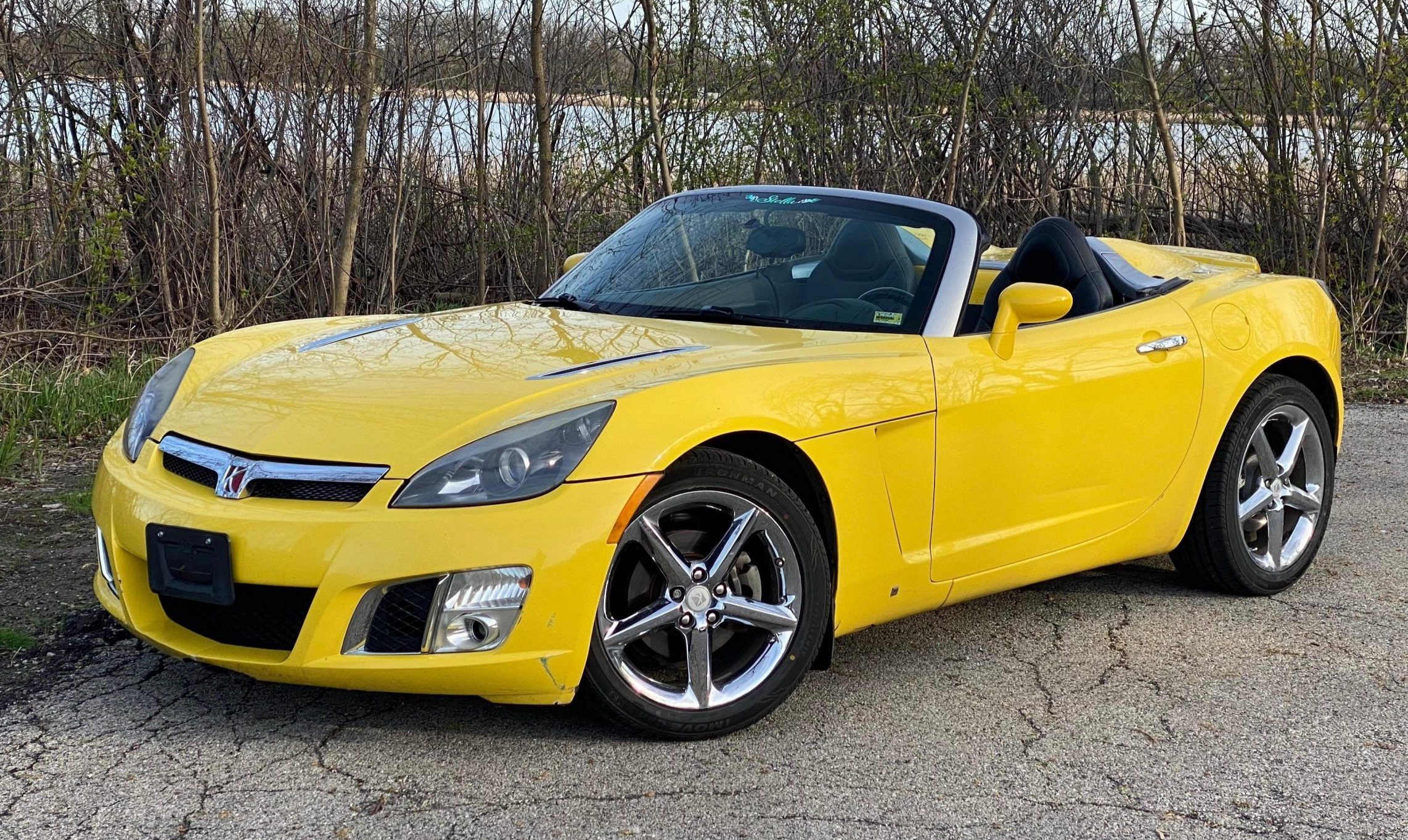
I didn’t get it. I stored these cars with completely dry interiors with their windows rolled up. Mold has no reason to attack my beloved Saturn! Then, I started to think about it. Remember when I said mold needs moisture, oxygen, 40 – 100 degrees, and a cellulose food source? While the interiors of my cars might not be wet, there’s a ton of moisture in the air – enough for mold to take hold.
I did some digging and found out I’m not the only one suffering with the stuff. People who park their cars inside barns sometimes find mold in them after just one season, even though the car was totally dry when it went into the barn. The issue is made even worse when the barn has an imperfect roof. That was the case in the story told by Rob Siegel of BimmerLife. Rob, like me, stores a lot of cars and tries to pay as little as possible for storage. In 2023, he ran into his own mold nightmare.
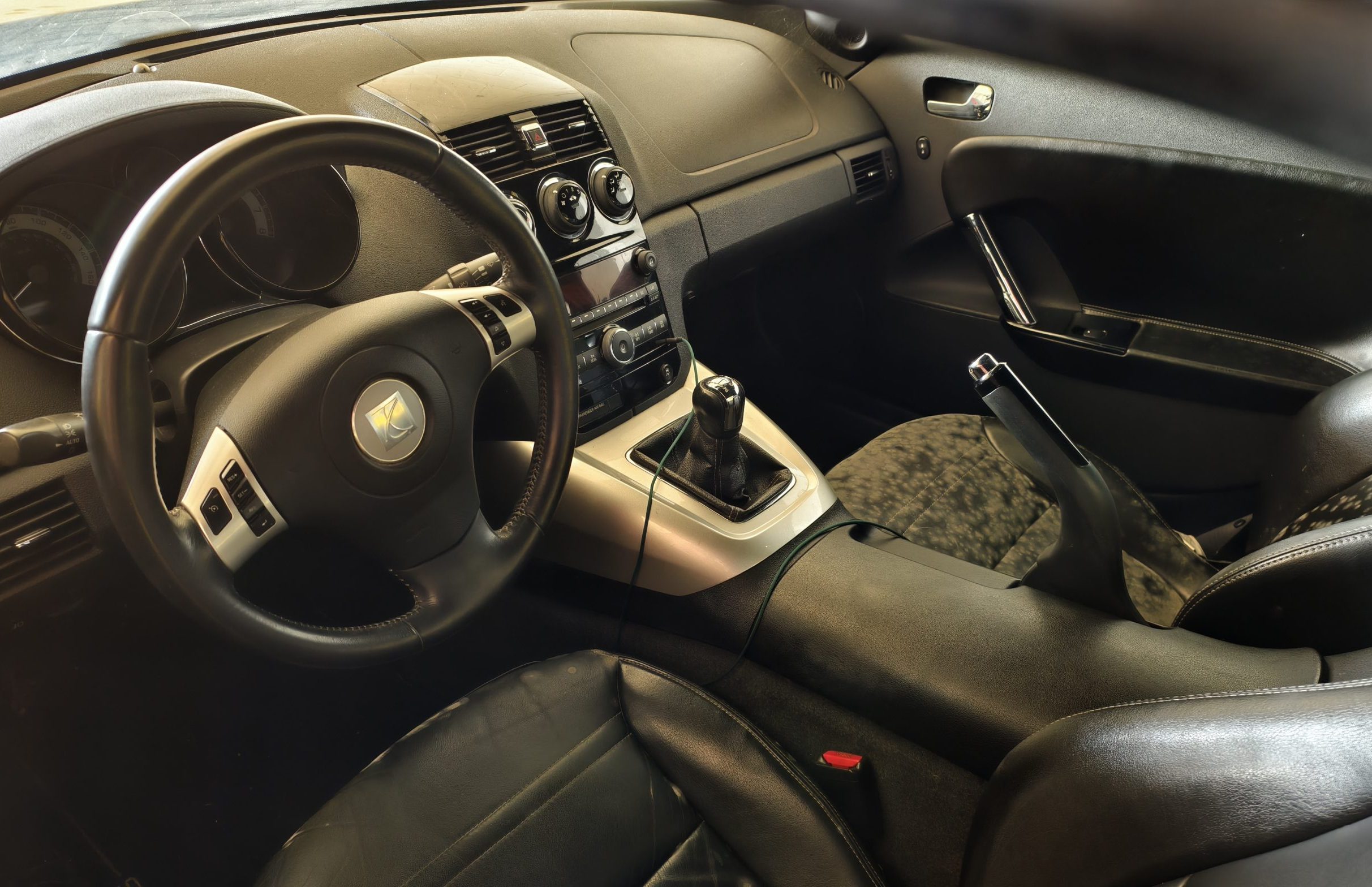
Based on my digging, it seems like there are two major recommendations for mold mitigation. One is to remove the moisture from the air. This can with a dehumidifier or possibly by deploying large amounts of moisture removers like desiccant cartridges or DampRid. Another tactic that seems to work is keeping the air moving around your storage place, so it never really becomes stale. A final recommendation is to simply visit the unit frequently enough to remove any water and to change out the DampRid, if that’s your line of attack.
My storage unit’s power is currently disconnected due to ongoing electrical work in the building, but once the juice is back on, a dehumidifier will be my first line of defense. But until then, in the absence of a dehumidifier, how do I stop mold from growing?

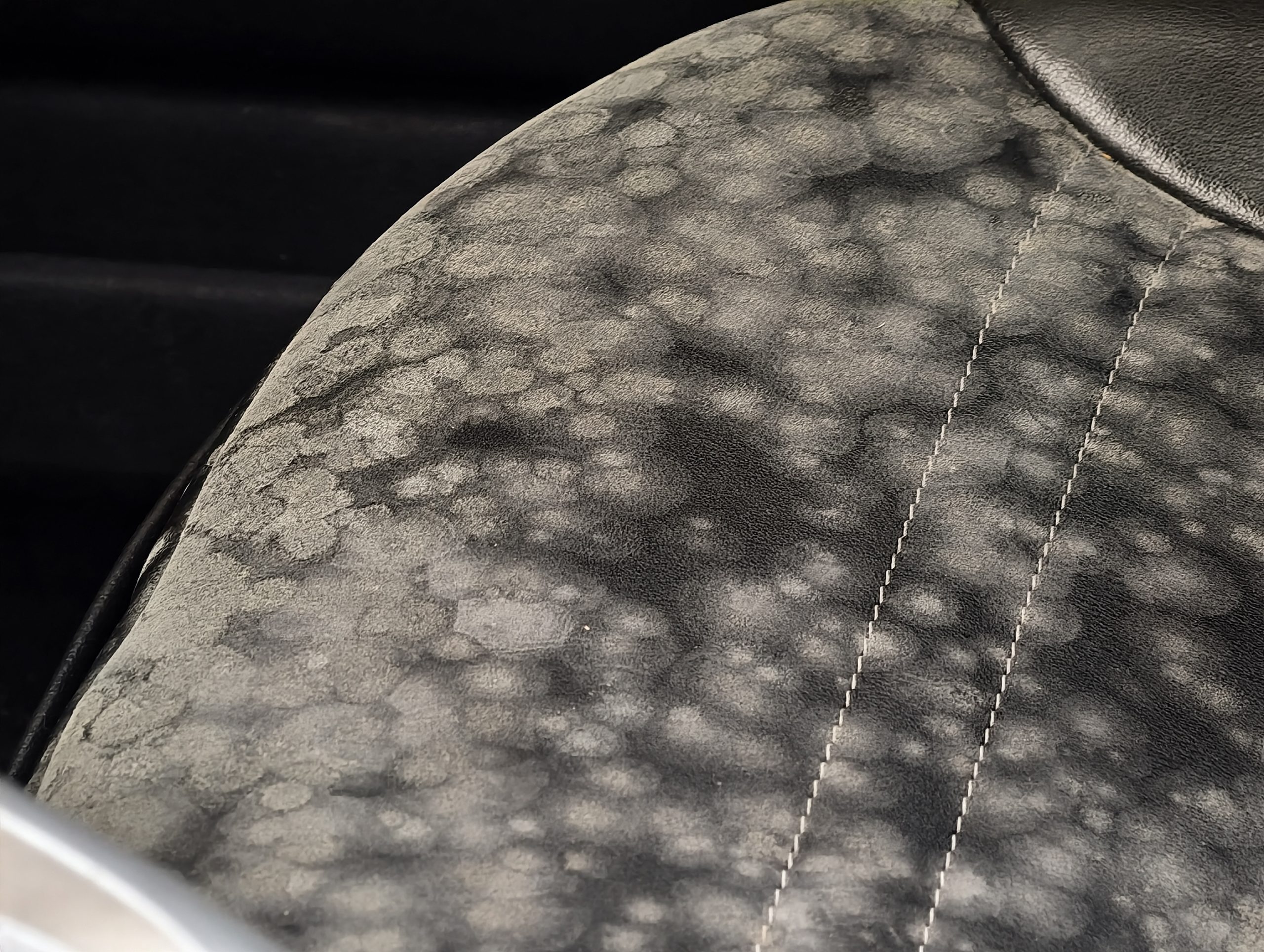
It looks like a lot of folks use desiccant bags inside stored cars, boats, and RVs, so maybe that is something that I will try. In the worst case, I’ll just waste a little money. Ultimately, I’ll use a dehumidifier, DampRid, and an ozone generator to aid in my cleaning.
As for killing the mold in the latest victims, my wife seems somewhat excited to help out. I won’t yuck her yum, so if she likes killing mold, I won’t stop her. I am not at all worried about cleaning up the cars.
What I am worried about is making sure that mold cleaning doesn’t become a regular thing for me. I have only partial confidence in my plan to deploy a dehumidifier, a fan for circulation, and DampRid. Here is where I will turn things over to you: How do you keep vehicles in seasonal or long-term storage from getting moldy?









Thank you all for the suggestions! I think I’m a bit more confident in what I’m going to do now. Electricity to my unit should be restored soon enough. Looks like my list of priorities will be air circulation and reducing moisture in the vehicles themselves. We’ll see what happens over the winter!
Also, sorry, Box Rocket, I have inherited David’s disease. I’m not interested in selling. But I do drive them from time to time, which is why they all have inflated tires and aren’t buried under inches of dust. 🙂
Dehumidifiers are certainly helpful but actual active (powered) air circulation is what is really needed here. I would consider finding a different storage facility if possible. Good luck.
Agreed. Ventilation first.
Your storage building should not be so humid, even when it is humid outside.
I hope you’re aware damprid can be dried out and reused.
It comes in some large sizes too.
Very humid here, so much it just spiked so the AC is on again.
Dehumidifiers make a *huge* difference, and at least one is needed here. If she can’t easily circulate the air of the entire unit, she can at least pull moisture out of the existing air. Only factors are electricity source and somewhere to run the humidifier’s water drain line.
Sheryl is a rare saint for doing the mold job! I personally use a dehumidifier with a built in pump but you can’t let it get cold so you need a heater and that helps, too.
Dehumidifiers will change your Life.
I use a Midea Cube with a built-in pump and I’ve never had to empty it. I would probably recommend at least two for your space since dehumidifiers need to be sized for a space like air conditioners.
An ozone generator might work, but it would have to be big and left on for quite some time due to the size of the space. If there’s a place near you that rents them, give it a shot.
Instead of an Ozone generator how about building a giant Tesla Coil. All those lightening bolts are sure to create mega ozone.
This is the kind of outside the box thinking I come here for!
This is probably a good idea in the short term. Something like rotating it through the cars for a few hours each just to kill as many spores as possible so it’ll take longer for the mold to come back if the moisture level rises. Or one of those chemical chlorine dioxide tablets plus a battery-powered fan, but the smell from those can kinda stick around an obnoxiously long time.
Not sure about the space as a whole – dumping enough ozone into the whole warehouse space to make a difference might be hazardous to neighboring units.
Ronald Finger has a YouTube video where he used ozone to deal with mold in his Pontiac Fiero restoration.
I love his channel!
I borrowed one of these when my old WRX developed a mold issue (both front seats were pretty well covered in it… rears were fine, I suspect oils/dirt from bodies in the seats were to blame). I wanted it for extra insurance, but I have heard excessive ozone use can cause plastics to age prematurely, so you might want to use it sparingly. I have no clue how much it helped, but I never had the mold return in that car (driving it more regularly probably helped… but that first year of COVID was rough).
When you go to car museums you’ll see dessicant packs in their cars for this exact reason.
Clean the interiors with cheap Gin or Vodka – and spray the same on the carpets and in the HVAC vents.
“Smells like you bin drinkin’! Step outta the car….”
“Rollin’ down the street, smokin’ indo
Sippin’ on gin and juice (laid back)
(With my mind on my money and my money on my mind)”
Just always park with a window open. Learned that the hard way myself too 😉
I recently inherited my dad’s BMW X3 (soon to be gifted to my daughter), which he occasionally smoked in. After a bit of research, I’ve been using an ozone generator to address the smoke smell to great success. From what I understand, it is also effective at killing mold spores.
I don’t recall if your warehouse has electricity, but if so you may want to look into one (I think I dropped $100 on amazon), especially if you can connect it to a timer to run automatically from time to time.
One thing to be weary of – Ozone gas is not safe to breathe, and while it has a very short half life and dissipates on its own, you would want to make sure that no one is accessing the space while the generator is running.
As a former boat owner and store-er, my $.02:
You’re going to need power.
I frequently had to put the boat in storage after a day on the lake knowing that there was water still in it. Here’s my tips based on keeping my boat mold free for 37 years:
Until you can get power, go the Damp Rid route. Get a couple of buckets per car, close them up in the car (windows up), and check them at least weekly. You’ll be surprised how fast they fill up with water.
Good luck.
I’d definitely be putting some moisture absorbers in your cars. I’ve been using the ones found at Dollar Tree for the past 8 years in my little teardrop camper that’s been parked under my parents deck. They work great and are much cheaper than the name brand ones (DampRid, etc.)
https://www.dollartree.com/the-home-store-moisture-eliminators-98oz/144947
I think you may be better off with the damp rid buckets in each vehicle than trying to dehumidify the space. Based on what I can see of the storage unit and my experience as an architect it is relatively easy to keep water out of a building but stopping water vapor basically requires you to have an air-tight enclosure. Because this is so hard to accomplish even in new construction almost all of our wall assemblies rely on never trapping vapor and allowing a way for the wall to dry out.
The strategy my family has used when storing cars seasonally – even in open machine sheds or corn cribs – make sure they are under a basic roof, loosely cover the car with a tarp or canvas and crack all the windows about 1/4″. The corollary to how tight you need to seal to eliminate moisture intrusion helps in that you don’t need a huge opening to let the moisture out either. Since you aren’t getting mold anywhere outside of the cars it’s possible just increasing the ability for the interiors to dry out will solve the problem.
Thin the herd. If cars are molding from non-use, you have too many cars. Hoarding them doesn’t make sense when the time you could spend driving them is spent disinfecting them. ????
Need to implement a “one in, one out” rule. After selling about half of what is there. Gotta keep those hoarder vibes in check or it’ll spiral as people age.
Get storage in the desert. Tucson Arizona perhaps.
Palm Springs is more fun.
On many levels.
Yikes! Fortunately boaters have lots of experience with mildew, so there are resources. Unless you can really condition the air in that space (with AC or a dehumidifier), I think moving the air and sticking damp-rid in dead spots, would be a big help. Boaters using these very gentle heaters called air dryers, but for a big space like yours it would probably make more sense to hang a couple incandescent light bulbs and run a fan just to mix the air.
For my slide-in camper (it IS a storage unit) parked outside I have a small fan with a timer running at unusual times just to circulate the air. Since we live in the low humidity (but highly flammable) California foothills, this may not apply. I do not have any windows open. I tried to put the camper ceiling fan on a timer and the motor burned out quickly.
Mercedes, when the power is back on, check out Dampp-Chaser. We used them on pianos, but they started out as a product to keep people’s clothes from molding in their closets. They list boats & RVs on their website. Not quite as cheap as they used to be, however.
This summer was really bad damp-wise here in SW Virginia. There were a couple months when I’d be remediating insulation on cold or chill-water pipes a couple times a week rather than once or twice a month or just on leaks.
You’re fairly handy at herding angry pixies: whip up a humidity-triggered power supply and put 2 or 3 of those 12w heater rods in your rides. Maybe the packets and rotate them out while you’re waiting for power to be back on.
Yeah I’d get like four buckets of damp rid per car, one for each footwell. They aren’t expensive compared to the potential damage to the vehicles, and in that quantity should last a good long while.
You may also want to start off your cleaning with one of those ozone bombs that Ammo NYC likes to use, they kill anything your cleaning might miss. He also has some products that may help prevent future mold growth.*
I have no affiliation with Ammo NYC, I just really enjoy his YouTube videos.
Ventilation is key. You need airflow much more than you need dehumidifiers – which (gasp) can actually attract and concentrate moisture, making things worse, not better, in the exact spot where you place them. So once again: ventilate.
Finding out how to increase airflow will be an interesting task. I wonder if the landlord will allow me to install a vent, maybe with one of those clothes dryer flap doohickeys.
If the motorcycle seats and that blanket on the Life (assuming it’s been there for a while) aren’t getting moldy I think the unit is probably drafty enough that just moving the air around within the unit is probably enough. It really doesn’t take large openings at all to equalize humidity and water vapor between 2 spaces.
This is a very good point. I see from the picture above that all of the windows are closed – it might be worth leaving them at least cracked open so that air can flow through the cars too. That’s going to be a balance between avoiding mould and making homes for critters though…
Yeah we have tried to mitigate that with mothballs under the hood and spread under the cars but there are definite trade-offs to balance.
If it’s allowed, keep an eye open for used commercial dehumidifiers. People will buy them after a flood/hurricane/pipe burst, realize they’re too big too easily store and too noisy to use regularly, then sell them off. They are power hungry, but you might be able to get away with running it intermittently.
The good ones are quite hungry: they are miniature AC systems. And you have to deal with the output.
I used an old big one in my basement garage to make it bearable to wrench in, and had to empty it often when wrenching regularly
I have been preaching the gospel of good dehumidifiers, and luckily Technology Connections just did a video on them, and talks about the differences too.
https://youtu.be/j_QfX0SYCE8?si=4FgLzF0iWKf4lkJl
He also is doing a series on engine fuel management. I would love to see an Autopian/Technology Connections crossover.
I would only ever bother with the AC style. The peltier or desiccant/heater versions just aren’t effective enough.
i suggested low wattage heater bars because they affect a smaller volume. And there is no water tank to empty. She could set up multiple single-car systems and not worry if she didn’t stop by storage for a few weeks. I imagine she doesn’t want to condition the entire space as that would quickly get costly.
I had mold issues in my car at one point. I told certain friends they no longer could ride with me.
Haha. But gross.
My advice would be to drive the cars more often and definitely use the AC. The AC will help dry out the interiors. Others have mentioned air flow and you said there’s nothing on your bikes, so maybe if you leave the car windows cracked there won’t be enough condensation to dampen the interior. Also, damprid is good stuff, but you have to remember to change it out regularly.
Using the AC can often be a big cause of mold if you don’t turn it off and let it cool down with the fan still running. Otherwise moisture condenses on the coils, drips down, and provides a perfect starting point for it to spread from.
Good point. I don’t know why I didn’t think about that. We recently had UV lights installed in our home systems because of mold on the coils (which means spores distributed throughout the house). Of course the same would happen in a car.
DampRid isn’t a panacea, but it’s definitely one part of things. Clean the shit out of it. Run the heater as high as you can, and then the dessicants to keep absorbing whatever else is gonna come out of there.
Source: I brought back an ex’s Mazdaspeed3 from the moldy brink because I loved her very much. Not such warm feelings about the ex though.
Heavy cleaning and turning the heater on is how we revived the Smart! But yeah, I’m thinking a good cleaning, dry the heck out of the cars, and then absorbents. Maybe, uh, maybe I’ll see if I can find a better sealed/ventilated unit, too. 🙂
Couple of suggestions. Get something like a pump up pesticide sprayer and go over all the walls of the unit with a watered down bleach to kill anything dormant and waiting to strike back. Ozone generate the cars first, but then let it run for a long time in the building too. Lastly and counter-intuitively, don’t store cars long term with the windows fully closed as they’ll accumulate moisture whenever the temperature drops suddenly such as at night or right before a big storm. You want to keep the interior temperature as close to the exterior and air temperature as you can (but unfortunately this does invite spiders in).
You don’t want to use a Ozone Generator more than you absolutely have to. It starts to break down the materials after awhile. Also, most ozone generators you have to manually turn a lever on to activate, so you can’t run one on a timer.
Huge affirmative on destroying materials!
My O3 generator as a timer and a manual setting.
When it comes to many things, the dose makes the poison.
In an area the size of a one- or two-car garage, an hour of ozone per day with a small 12000mg/h generator may or may not degrade automotive plastics. It’s a risk to be sure, and one never knows which materials are affected until it’s too late.
Were it me, I’d hit the space with an O3 generator, check for any degradation, then act accordingly.
Careful with the ozone generators, now. We used them to kill smoke smell after pianos had been in fires. Certain rubbers will degrade rapidly when exposed to strong ozone. My daughter’s car was in a flood during that period—and she was several hours away. After initial drying, I left her with several Dampp-Chaser brand piano dehumidifiers rather than one of our ozone generators as we had had window seals in a camper go brittle when exposed.
this is not financial advice, do your own research, blah, blah. Just my experience
(and certainly one of the ones we used was >way< over-powered: the rubber grippy bits of my dremel crumbled over several weeks after I left it in the sequester room with a smokey piano over the weekend)
You are correct. Definitely don’t overdo it. I have a small $40 one and the 2 times I’ve used it in the car it was only for 30-60 minutes. In the basement after a flood I’ve left it on for about 12 hours, and guessing it would need about a day for a space as big as hers to be effective. To clarify also, you use the ozone generator to prevent the mold from spreading / coming back, it’s in no way a replacement for cleaning it first.
I have a car I park for the winter and have avoided mold by driving it around in the late fall with the heat cranked with the AC on to help really dry out any moisture. I make sure I empty it of anything that could be damp too. Couple of the damp rid hangers in the interior and one in the trunk. If I think of it I swap them out during the winter. Also make sure I close the windows tightly.
Since it is parked outside I also make sure to brush the snow off. Maybe being outside helps, maybe it doesn’t.
It’s also very important that you keep the fan on for a while with the AC off before you park a car so the evaporator inside the car can warm up to ambient before you turn the car off, otherwise the condensation is a perfectly inaccessible breeding place for mold to spread from. I always try to turn the AC off 30-60 seconds before I get home.
Mold is a fairly easy issue to diagnose.
Mold spores (the things that molds grow from) are obliquitous in our environment. The key to stopping the spores from blooming into what you are seeing is denying them at least one of the three things they need to grow.
Food: The seats are providing a food source (possibly from dirt or from the fats in leather).
Temperature: They like moderate temperatures…if it feels comfortable to you…mold spores are comfortable too.
Water: The spores need water to generate into mold bodies.
My guess is that dehumidifying the air in the car would solve the problem…as the other two factors are more difficult to deal with. If you don’t want to run and electrical dehumidifier…then a chemical one (silicone gel sacks) in a closed car might work.
One last thought would to be making certain the heater core or A/C cooling coils are clean and not storing water.
Hope this helps clean up the situation.
The other thing to consider is that if there is enough moisture to grow mold, there is enough to cause rust. Many cars have rusted to death sitting indoors in a space that was just a bit too damp. Running a dehumidifier to make a noticeable difference might cost more than the price of a better storage solution. Airflow is a significant factor as well. You need some.
Or, you can get those inflatable bubbles.
I was concerned about rust, too. Thankfully, I have not noticed any additional rust on the vehicles. Even the Honda Beat, which was already rusty when I bought it, stayed largely the same over my four years of ownership. But its steering wheel did get moldy. Ugh. So it seems to be damp enough to make mold, but not enough to cause me rust issues…well, not yet, anyway.
One perk about my unit is that electricity is included in my rent, and I already use the power for battery tenders and whatnot. My landlord just made me promise that I wouldn’t live in the thing. lol
Free electrons! Sweet! Dehumidify away!
Might as well mine bitcoins or something too!
I had the same problem in my (somewhat ramshackle) garage. My solution was to open the garage door and leave it open. Unfortunately that may not be a wise option in your storage unit. Is there at least an opening somewhere for ventilation? If so, then can you install a fan over it?
It would seem you need to get a different storage situation.
Yeah, I’m beginning to realize it might be time to get an upgrade. It’s a shame, too, because this unit is so close to home, making it super easy to just swap out cars at free will.
You could probably get by with a good dehumidifier! You just need to figure out the drainage solution, is there somewhere you could run a hose to drain it outside or would you need to go and empty the tank by hand? That plus damp rid inside your cars ought to do the trick. But I’d definitely be looking for other options if there was evidence of an active roof leak!
Drainage would be super easy, barely an inconvenience! I could just run a hose to the drain outside. Ventilation would be the hard one to solve, as there aren’t any real “holes” in the unit to put a vent.
To be fair to my unit, I have not found evidence of an active roof leak, just evidence of a previous roof leak. The landlord did admit that the roof had problems in the past, but, apparently, the roof is new. But it’s weird, because I went three years without any mold in any car. So, something had to change, maybe?
Air conditioning will dry the air.
Maybe a few thousand of those little “Do Not Eat” paper sachets filled with silica would help.
This is a terrible idea, but now I want to see if Autopian can get someone to sponsor an article to test commercial dessicant vs powered dehumidifier vs packing the entire car with Do Not Eat sachets.
I mean, this is a deeply funny idea, and I’m crazy enough that I’d actually give it a try. I mean, I have the cars, and clearly, good enough testing conditions.